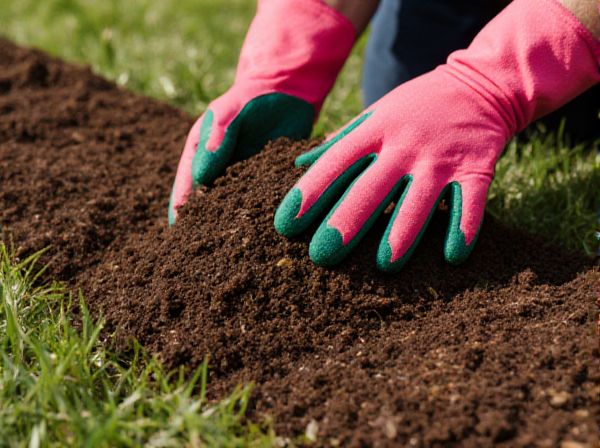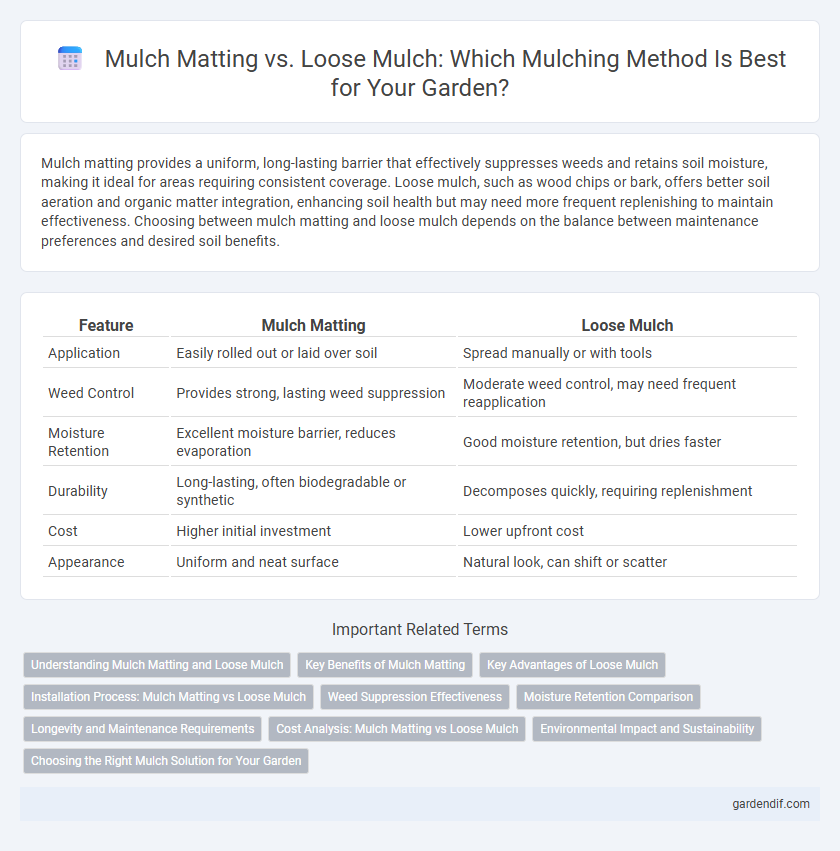
Mulch matting vs Loose mulch Illustration
Mulch matting provides a uniform, long-lasting barrier that effectively suppresses weeds and retains soil moisture, making it ideal for areas requiring consistent coverage. Loose mulch, such as wood chips or bark, offers better soil aeration and organic matter integration, enhancing soil health but may need more frequent replenishing to maintain effectiveness. Choosing between mulch matting and loose mulch depends on the balance between maintenance preferences and desired soil benefits.
Table of Comparison
| Feature | Mulch Matting | Loose Mulch |
|---|---|---|
| Application | Easily rolled out or laid over soil | Spread manually or with tools |
| Weed Control | Provides strong, lasting weed suppression | Moderate weed control, may need frequent reapplication |
| Moisture Retention | Excellent moisture barrier, reduces evaporation | Good moisture retention, but dries faster |
| Durability | Long-lasting, often biodegradable or synthetic | Decomposes quickly, requiring replenishment |
| Cost | Higher initial investment | Lower upfront cost |
| Appearance | Uniform and neat surface | Natural look, can shift or scatter |
Understanding Mulch Matting and Loose Mulch
Mulch matting offers a structured barrier that suppresses weed growth while retaining soil moisture effectively due to its synthetic or natural fiber composition. Loose mulch, made from organic materials like bark, straw, or compost, enriches the soil as it decomposes and improves aeration but requires more frequent replenishing. Understanding the differences in durability, moisture retention, and soil enrichment helps gardeners select the appropriate mulch type for specific landscaping or agricultural needs.
Key Benefits of Mulch Matting
Mulch matting provides superior moisture retention and weed control compared to loose mulch, creating a consistent protective layer that supports plant health. It reduces soil erosion and compaction by stabilizing the soil surface, enhancing root development and nutrient absorption. This durable solution requires less frequent replacement, making it cost-effective and environmentally sustainable for long-term landscaping maintenance.
Key Advantages of Loose Mulch
Loose mulch offers superior soil moisture retention compared to mulch matting, enabling better water infiltration and reduced evaporation rates. It enhances soil aeration and promotes beneficial microbial activity, leading to healthier plant growth and improved nutrient cycling. Loose mulch also provides more flexibility in application, allowing for easy redistribution and replenishment as needed throughout the gardening season.
Installation Process: Mulch Matting vs Loose Mulch
Mulch matting offers a streamlined installation process, requiring the mat to be rolled out evenly over the soil surface, which minimizes labor and ensures consistent coverage. In contrast, loose mulch demands more effort for spreading and layering, often needing frequent replenishment and adjustments to maintain an even protective layer. Installation time for mulch matting is generally faster and less prone to displacement from wind or water compared to loose mulch.
Weed Suppression Effectiveness
Mulch matting offers superior weed suppression effectiveness by creating a dense barrier that blocks sunlight and prevents weed seed germination more efficiently than loose mulch. Loose mulch can shift or decompose unevenly, allowing gaps that enable weed growth, reducing its overall weed suppression capability. The consistent coverage and durability of mulch mats make them ideal for long-term weed control in gardens and landscaping projects.
Moisture Retention Comparison
Mulch matting provides superior moisture retention compared to loose mulch due to its dense, uniform layer that reduces evaporation and prevents water runoff. Loose mulch, while beneficial for aeration and soil warming, tends to dry out faster under direct sunlight and wind exposure. Studies show mulch matting can retain up to 30% more soil moisture over a two-week period, enhancing plant hydration during dry spells.
Longevity and Maintenance Requirements
Mulch matting offers superior longevity by resisting decomposition and displacement compared to loose mulch, which often requires more frequent replenishment due to degradation and wind erosion. Maintenance for mulch matting is minimal, needing occasional inspection and repositioning, whereas loose mulch demands regular replenishing and raking to maintain even coverage. Selecting mulch matting reduces labor and material costs over time, providing a durable solution for soil moisture retention and weed suppression.
Cost Analysis: Mulch Matting vs Loose Mulch
Mulch matting typically incurs higher upfront costs due to manufacturing and installation expenses, while loose mulch offers lower initial investment but requires more frequent replenishment. Over time, mulch matting can reduce labor and maintenance costs by minimizing weed growth and soil erosion, providing long-term savings. Cost efficiency depends on project scale, durability needs, and ongoing maintenance budgets, making loose mulch preferable for short-term or budget-conscious applications.
Environmental Impact and Sustainability
Mulch matting offers superior soil erosion control and moisture retention, reducing the need for frequent watering and chemical inputs, which enhances environmental sustainability. Loose mulch, while biodegradable and beneficial for soil health, may decompose faster and require more frequent replenishment, potentially leading to increased resource use over time. Choosing mulch matting over loose mulch can contribute to long-term ecological balance by minimizing waste and promoting efficient nutrient cycling.
Choosing the Right Mulch Solution for Your Garden
Mulch matting offers superior weed control and moisture retention by creating a stable barrier that prevents soil erosion, making it ideal for long-term garden beds. Loose mulch provides flexibility for decorative uses and quick nutrient release as it breaks down, suitable for seasonal planting and areas with frequent plant changes. Selecting the right mulch involves assessing garden goals, such as soil protection, weed suppression, aesthetic appeal, and maintenance preferences.
Mulch matting vs Loose mulch Infographic

 gardendif.com
gardendif.com